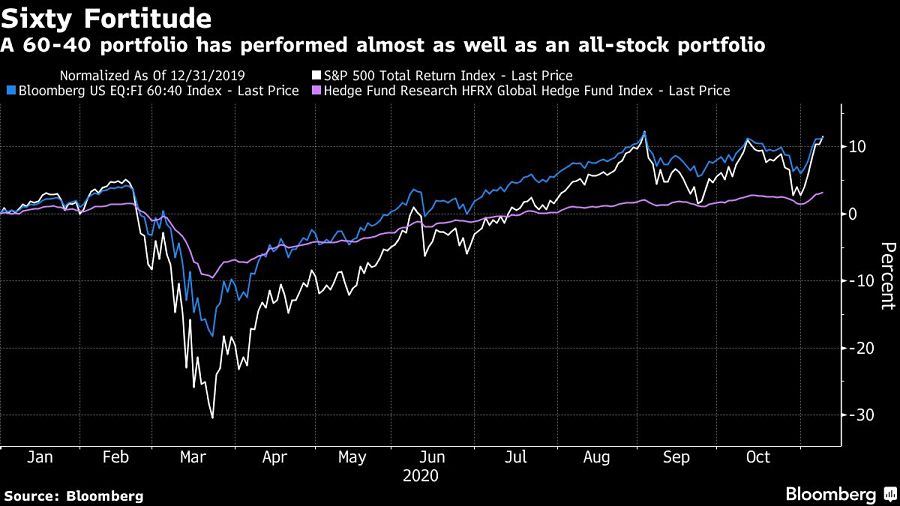

For decades, a balanced portfolio of stocks and bonds was among the few venerated precepts in investing. Yet doubts about the approach grew after the pandemic hit and turned 2020 into a year like no other.
For all the handwringing, it looks as if it will be another year of solid performance for 60/40. A model portfolio composed of 60% U.S. stocks and 40% bonds has climbed 13% year-to-date, according to a Bloomberg index. That’s in line with the rally in the S&P 500 Total Return Index and bigger than the 3.5% gain in the HFRX Global Hedge Fund Index.
The strategy’s resilience is a rebuttal to the many critics who have been calling for its demise for some time. Late last year, Morgan Stanley predicted a period of anemic returns for a typical 60/40 portfolio, and this year, a debate began on potential alternatives to bonds in the strategy as yields slumped to historic lows.
“The big surprise is how well the 60/40 portfolio has done in a year like 2020 -- it has been right on the historical average,” said Vincent Deluard, global macro strategist at StoneX Group Inc. “And 2020 has been nothing like an average year.”

Adding a hefty chunk of bonds to a basket of stocks has been a staple of diversified investing for decades, with the more stable fixed-income component acting as a balance to riskier growth-sensitive equities. This year has seen periods when stocks and bonds have moved together, which critics have seized upon to disparage the strategy.
The argument went that bonds can’t be a hedge against equities if they both rise and fall together. But that’s a misunderstanding of the concept of 60/40 investing, one meant to result in a diversified portfolio for the longer-term investor, not a short-term focused absolute-return hedge fund.
Even over the short-term, a blended portfolio has proved resilient. At the height of the coronavirus fears in March, the Bloomberg 60/40 portfolio fell less than the S&P 500 Index -- a sign of the benefits of diversification in action.
Still, caution abounds about a balanced approach. Deluard, who earlier this year warned of a “nuclear winter” for 60/40 portfolios harking back to the decade-long bust in the 1970s, said the strategy faces tougher times ahead.
Nathan Thooft, global head of asset allocation at Manulife Asset Management in Boston, noted that while the strategy is “not dead,” return expectations for a traditional balanced portfolio are “likely to fall well short of the last several decades.”
JPMorgan Asset Management recently cut its expected returns for a 60/40 portfolio to 4.2% for the coming years, though it also lowered growth forecasts for global equity portfolios to 5.1%.
For Societe Generale strategist Solomon Tadesse, the deflationary pressures unleashed by the coronavirus pandemic and the unprecedented monetary-policy response it triggered are likely to result in lower correlations between various asset classes going forward. That should benefit 60/40 investing, he said.
“The skepticism on 60/40 and more generally cross-asset performance was misguided as it did not account for the huge tailwind behind asset-return correlations,” Tadesse said. “I do expect the strong performance of the strategy to continue.”

The 25-year industry veteran previously in charge of the Wall Street bank's advisor recruitment efforts is now fulfilling a similar role at a rival firm.

Former Northwestern Mutual advisors join firm for independence.

Executives from LPL Financial, Cresset Partners hired for key roles.

Geopolitical tension has been managed well by the markets.

December cut is still a possiblity.
Streamline your outreach with Aidentified's AI-driven solutions
This season’s market volatility: Positioning for rate relief, income growth and the AI rebound
